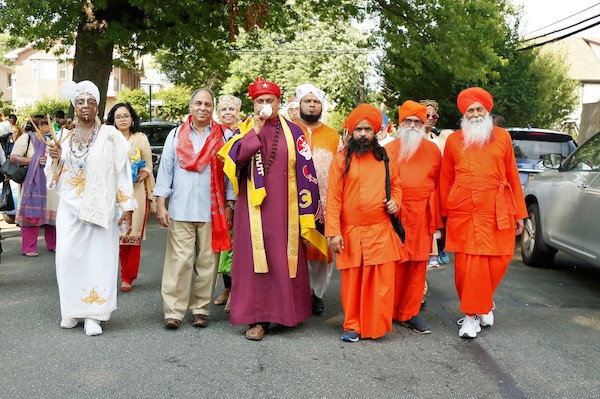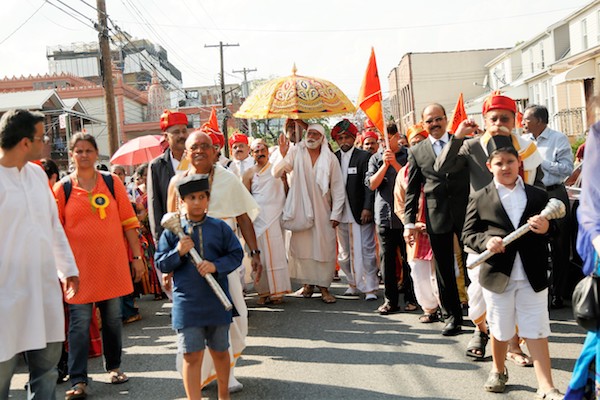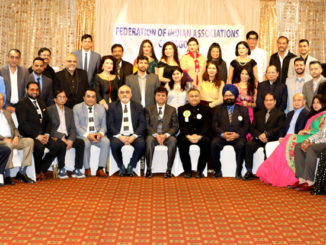
FLUSHING, NY (TIP): Shri Shirdi Saibaba Temple, the oldest house of worship in the US for the revered saint, has taken out a palanquin procession marking the culmination of weeklong Guru Purnima celebrations.
The celebrations, part of the centennial of Maha Samadhi of Shirdi Saibaba, drew a total of 5,000 devotees. The highlight of the annual celebrations was undoubtedly the procession, which this year was renamed as Ek Yatra.

The procession is usually known as Palki (also known as Palkhi or Pallaki) Yatra. Ek Yatra, in which representatives of all religions formed a major interfaith segment, comprised nine parts representing each of the nine forms of devotion to god. Saibaba propagated and worked for the unity of all Indian and other world religions in his lifetime, mostly spent at Shirdi village in Ahmednagar revenue district of present-day Maharashtra.
A dance troupe and a music band representing Indian ethnic groups — mainly Maharashtrian — drew particular applause from participants in the procession and onlookers on the sidewalks of the Flushing neighborhood in Queens, New York City.
Shiva Haran, the temple president, estimated that 1,200-1,300 people participated in the celebrations on Saturday, July 28 afternoon, when the yatra was held. There were also scores of people waiting in the house of worship to receive the participants.

The re-enactment of Chavdi Utsav (the festivity at a public place in an Indian village), which used to be taken out from Dwarakamai (a dilapidated mosque that Saibaba made his home) at Shirdi, was another feature of the yatra. The person who appeared as Saibaba, all through the procession with full makeup as the saint, drew tremendous praise along with his associates such as Hemadpant, Madhvrao Deshpande, Nanasaheb Chandorkar and Kaka Mahajan. A horse also formed part of the procession to give authenticityto the yatra.
Haran and other temple officials appreciated the temple volunteers, numbering more than 100, who helped conduct the yatra in an orderly manner.
One such volunteer spoke to some participants in the procession. “It was excellent. Unbelievably great,” said Haran, who also walked as part of the yatra. “I should say it is perhaps the biggest such event outside India. The Punjabi-Maharashtrian dhol; women wearing Marathi-style saris dancing to the rhythmic music; and the all-round enthusiasm of the participant-devotees as well as the onlookers remind us all of our motherland. I felt as if the Chavdi Utsav was re-created here in Queens.”

The band-and-dance troupe, as well as the horse, came from neighboring New Jersey, exclusively for the event.
Narasimha Rao Bonda, the main coordinator of the procession, was equally enthusiastic. “Baba himself helped us stage the spectacular event. It has never happened here (in the US) and might not happen again in our lifetime. He was there everywhere and showered his blessings on everyone,” Bonda said with excitement.
According to Madhavan Krishnamachari, who holds his own religious events twice a year, said the procession – with Ek Yatra and the ethnic music and dance segment – should become an annual feature of the Saibaba temple. He was glad that all this happened in 2018, the centenary year of Maha Samadhi of the saint.
An IT consultant in New York who is in his 40s, Satish Sabarad, was the cynosure of all eyes. He appeared as Saibaba. When he was coming out of the temple, a few devotees were seen bending and touching his feet. He himself sounded highly devotional.
“It was once-in-a-lifetime opportunity to appear as Baba,” he said. “I came to know about my role in the yatra just three weeks before the event.
I was initially hesitant, but persuaded by B.R. Surendra (aka Barasu, the makeup man for the whole Saibaba team of associates). Sabarad acted in a few stage shows, but never before he had this type of role.
Harvinder Singh Karir felt as if he literally went back in time when he played the role of Kaka Mahajan, a senior Baba associate. The 49-year-old, who works with the federal government, appeared in black coat and with the traditional Maharashtrian headgear of that time walking along with the man appearing as the saint.
A 53-year-old attorney, Srinivas Kaveti, opined that even in India it is not easy to re-enact this kind of processions. “It simply was amazing,” he added.
Mukund Khisty works for India Roots, a nonprofit based in New Jersey that does charitable work in India, mostly Maharashtra. He and his 100-member group consists of professionals such as doctors, engineers and lawyers.

The group staged the music-and-dance show during the three-hour procession. “We do this kind of shows, but I feel this was our exclusive performance.”
A member of the interfaith segment said that along with other houses of worship, he visits the Saibaba temple once a month. Raj Bhushan’s is a multi religious family as he married a Muslim, his daughter-in-law is Jewish and daughter is married to a Christian. “If one tries to understand others’ religions and cultures, the world will be a more peaceful place to live in,” he remarked. Known also as Brother Oneness, Bhushan — a retired person — still occasionally takes up immigration issues.
A woman who practices Yoruba, a religion mainly based in Nigeria, said ruling classes in several African nations practice it. Nana Zakia, who lives in Harlem in NYC and sporting shiny stripes on her face, had just one thing to say: “Spread everything that is good and be tolerant of others.”
The Flushing temple, though formally inaugurated in 2010, has been in existence for the last 30 years. There are nearly 50 houses of worship in the US dedicated to the Shirdi saint. During the centenary year, the Flushing temple’s activities include the Maha Samadhi celebrations (set for the third week of October during the Navaratri) and a major fundraiser to be held later that month.
There is also an ongoing quiz program on the life and times of the saint. Prizewinners will be felicitated later this year, and the top scorer will have a chance to get a roundtrip ticket to Shirdi (courtesy Air India).
That person will be eligible for a VIP darshan. There is a second spot, which is worth $500, and two third prizes. There is also a possibility of a few consolation prizes. For further info, please visit www.dwarakamaishirdi.org





Be the first to comment